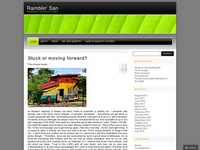- Home » Expat Contests » Expat Blog Awards 2013 - Top Ten Considerations for Bringing a Dog into Belize
Top Ten Considerations for Bringing a Dog into Belize
By: Ramblin San
Top Ten Considerations for Bringing a Dog into Belize – It’s NOT EasyDogs are members of our family, so where we go, they go, and they share in the adventure!
1. If you are importing a dog from the US into Belize, you will need to have all the proper paperwork both for the airline and for BAHA (Belize Agricultural Health Authority). (Refer to point #3 for BAHA requirements). To avoid a 30 day quarantine, you will need to have the USDA APHIS Form 7001 filled out within 7 days of departure by a USDA certified veterinarian who is licensed in your state (find one near you). FED EX overnight the Form 7001 with a check (the fee for stamping/endorsement varies by the number of animals traveling and by the number of tests required for the health certificate. You should contact the APHIS VS Area Office in your state for more information- I think I paid $37 for each dog in 2012) to your states’ USDA (United States Department of Agriculture) APHIS (Animal and Plant Health Inspection Service) AVIC (there is probably only one office in the state for the Area Veterinarian in Charge) with a prepaid return FED EX overnight envelope for them to return the endorsed form back to you. Then pray that the endorsement gets back to you before your flight! Refer to this site to answer more questions you may have.
2. While you are at the vet in the US before your flight, have them fill out the required paperwork for your airline, the IATA Veterinary Certificate For Domestic & International Airline Travel. Be sure to carry valid proof of your pet’s current rabies vaccination (not less than one month or more than one year prior to the date of importation into Belize) with you to the vet, the airline, and BAHA. Information for shipping a dog via United/Continental may be found here. For information about shipping dogs with American Airlines go here. Note the ridiculously large kennel size required for international travel (the flights from Houston or Dallas are less than 3 hours). The kennel needs to be ventilated on all four sides (we had to drill holes in our fourth side because we couldn’t find the proper brand and size of kennel at regular pet stores in the US that were ventilated on all four walls) for international travel and airlines will not accept certain brands of kennel, so be sure to check before purchasing one. It is possible that the airline will sell one to you that meets their requirements. You may want to check with them if they do this and it may save you a lot of trouble beforehand. Kennels need to be properly labeled, contain secured food and water dishes, with a large ziploc bag of dry kibble and a leash taped to the top of the kennel. Certain sizes of kennels may not fit in the cargo holds or through the cargo door in an upright position for certain types of aircraft, so you need to check what make of plane you have booked for your pet’s flight. Note that airlines will refuse to ship certain short nosed dog breeds. I would recommend finding a direct flight with no connections. You would hate for your dog to be lost on some tarmac somewhere unattended! We drove a long way through the US to make sure we could get our dog on a direct flight from Texas. I would also recommend that you be on the same flight with your pet, so you are there to pick it up quickly. Most importantly, the airlines WILL NOT ship a dog in the cargo hold if the temperature at either airport is over 85F (and it is very tough to find days less than this temperature in Belize). This pretty much means that you will not be able to ship pets that are too large to travel in-cabin in the summer. Realize that you will need to drop off your dog in the cargo area for your airline 3 hours before your flight. You will need to be ready to pay fees (probably around $US50) in addition to what you already paid for their travel fare when you drop them off.
3. To import a dog into Belize, you should visit the BAHA website . Download and fill out the application to import animal(s) into Belize. Either send your application by Fax to 011-501-822-0271 or E-mail to [email protected]. It should processed in about 7 days, but NOTHING in Belize is efficient or quick, so you may need to keep on them and continue asking for the approved import permit to be faxed back to you. It is probably best to deal with the BAHA in the capitol city of Belmopan (their phone numbers are 011-501-822-0818/1378/0197 or you may try the e-mail mentioned previously). BAHA claims they will file the import permit at the airport, but when you arrive, BAHA officials there will refuse to even look for it and will say it is not there in attempt to line their pockets (holding your dog for ransom). To avoid this, you will need to have a copy of the BAHA approved import permit in your hot little hands! You can whip it out and not have to pay a fee or bribes to get your pet into the country. If your import paperwork is not at the airport, you will at least be charged a $B50 fine. The BAHA website says, “The Director of Animal Health is to be notified two (2) days in advance of date and time of arrival of live animals at point of entry. Veterinary inspection at point of entry will be done only during daylight hours (9 am - 4 pm). For your information, the telephone numbers of veterinarians that can be contacted are:
Dr. Victor Gongora - Central Farm- Ph: 011-501-824 - 4872/99 (Director of Animal Health)
Dr. Joe Myers - O/Walk - Ph: 011-501-322-3257 (Quarantine, Northern Districts)
Dr. Miguel Depaz - Central Farm - Ph: 011-501-824-4872/99 (Quarantine, Cayo District)
Dr. Miguel Figueroa - Belize City - Ph: 011-501-224-5230/4794 (Quarantine, Belize District)”. I did call prior to shipping our dog and they said a vet is always there anyways (so no need to call), but we have never seen nor needed one, so I'm not really sure about this.
4. Belizean customs sets an arbitrary figure to charge you based on the value they determine of the freight (they determine how much your dog breed is worth and then charge you a percentage that customs agent determines that day). If you negotiate with them in a good natured manner, they will usually lower the fee for you. We had to pay an unexpected $277 for them to release our dog. You will need to be ready with some cash for expenses like this.
5. You will need to consider how to transport your dog and kennel in your vehicle. We booked an SUV with Hertz, but the extra large kennel we were required to use for international travel did not fit inside, and the SUV lacked a rack on top. We had to go to another rental car agency that had an SUV with a rack on top. We had to borrow some rope to tie the disassembled kennel to the roof (we didn’t want to try to drive with one hand on the steering wheel and hold onto the kennel on the roof with the other hand like you see some people doing with mattresses – yeah, THAT works!) You may want to bring some rope or bungee cords with you (good bungee cords are nowhere to be purchased in Belize that we could find)
6. Our American dogs were used to hiking off leash in the US forests, socializing with other friendly dogs, and running up to people to make friends. Socializing with Belizean dogs is not possible in Belize. In Belize, most dogs are used for home protection/attack or else they are stray/feral dogs, most likely carrying disease, who commonly fight each other in the streets, especially at night. Bitches in heat who are free to roam are usually the ones over whom they are fighting. Most people in Belize have been bitten by a dog and many are very afraid of them. We were hiking (our dogs knew to always stay on the trail because stepping off trail into leaf litter could result in a snake bite) in what we thought was a “people free” area of the jungle and a large man came out onto the path where we were, so our dog happily trotted up to greet him. The man picked up rocks and chucked them at our dog, claiming he was being charged and that the dog would attack him. We kept yelling for him to stop, that our dog was friendly, but he kept right on throwing rocks. From that point on, we kept our dogs on leash at all times. We had several friends get bitten by protection dogs other people were walking, even when they were on leash, so it is best not to even approach dogs that look like they are under the control of their owner.
7. It is a good idea to take a “cone of shame” (aka Elizabethan collar, E-Collar, pet lamp-shade, or pet cone) that fits your dog with you into Belize, because we could not find one anywhere (they were all too small….Chihuahua sized only) to use on our dog when he was neutered. If your dog incurs any kind of injury that you would want to keep him or her from licking and reopening, you will need to bring a cone with you from the US.
8. If you need vaccinations or grooming in Belmopan, try Sylvestre and Maylin Trejo. They may be contacted at 501-602-1033, or 501-625-7511. Their “office” is a picnic table in their front yard (a surprise to us) but it works. Their vaccination cards are in Spanish and we found upon returning to the US, that our city would not license our dogs with a Spanish rabies certificate. They needed to be revaccinated in the US before they could be licensed (silly). I said, “It’s really not that hard to read even though you don’t speak Spanish. Use your deciphering skills! Vacunación means vaccination, contra means against, and la Rabia means rabies!” How hard is that? (As an aside, Maylin also works at the Venezuelan Institute at the intersection of Floriana Ave. and Orchid Garden where you can take free Spanish lessons - even though English is the official language of Belize, 63% of the population there speaks Spanish)
9. If you need a vet, try Dr. Isabelle Paquet-Durand at Belize Wildlife Clinic (her office is difficult to find with a very small sign just beyond the University of Belize Central Farm and a little airport across the street from Flying W Meats in Cayo on the Western Highway going towards San Ignacio from Belmopan). She works with exotics, but treats domestic animals to pay the bills. She has done a great deal of research about parasites. Don’t even bother to bring Heartgard with you into the country. Your pet will need something much stronger to take care of all the parasites in the area – Ivermectin. We used Advantix (which we brought in with us – I think you can purchase only Frontline in Belize) and did not have any trouble with ticks or fleas. Fleas especially can be an unpleasant problem in Belize, so it is worth it to protect your dog. Thankfully our dogs stayed healthy in Belize.
10. For pet supplies in Belmopan, Reimer's feed on Constitution Drive (501-822-2088) is probably your best bet (for food, Frontline, collars, treats, but not really for toys or good long lasting things to chew). Reimer's is Mennonite owned out of Spanish Lookout. You can buy American made dog food (even in the Chinese/Taiwanese owned grocery stores), or the Mennonites make their own dog food, which is cheaper than the imported stuff because of the high duty Belize charges on EVERYTHING brought into the country. (Don’t buy into the idea that it is cheaper to live in Belize than in the US – it’s not!) “Owning a dog is slightly less expensive than being addicted to crack.” ― Jen Lancaster, Bitter is the New Black. There’s no such thing as a free dog!<
However, they are invaluable companions…..
“A person can learn a lot from a dog, even a loopy one like ours. Marley taught me about living each day with unbridled exuberance and joy, about seizing the moment and following your heart. He taught me to appreciate the simple things-a walk in the woods, a fresh snowfall, a nap in a shaft of winter sunlight. And as he grew old and achy, he taught me about optimism in the face of adversity. Mostly, he taught me about friendship and selflessness and, above all else, unwavering loyalty.”― John Grogan, Marley and Me: Life and Love With the World's Worst Dog
Grab a badge that links to this contest entry!
 Copy and paste code to display this Contest Entry Badge:
Copy and paste code to display this Contest Entry Badge:Contest Comments » There are 8 comments

Faith Wilson wrote 11
years ago:
Wow! It really does look like a difficult task to bring dogs into Belize, but I'm sure it was worth it!

Amy Fish wrote 11
years ago:
Wow! It can be a real pain to travel with pets but family is family!

Lana Kruse wrote 11
years ago:
Lots of valuable info for transporting waggily friends but I loved what you learned from a dog! I learned to love unconditionally and SHOW it! You know--wag my tail more often! Humans need to appreciate others and tell them, like dogs do all the time with their actions. We can add words to that, too!

David Provost wrote 11
years ago:
So, I'm a cat guy since college. Your tale (no pun intended) gives new incite to travelling with pets. You gotta love the beaucracy of it all!

Craig Turner wrote 11
years ago:
thanks for a wealth of great information. A dog is man's best friend

Charlie Williams wrote 11
years ago:
Thanks for posting all the details for bringing a dog into Belize. I hope folks will follow your suggestions and make it as easy as possible on the people and especially the dogs! Charlie

Cary Smith wrote 11
years ago:
Dogs rule! They are the best most loyal friends you could ever have. Take them with you everywhere you go.

Brody Boy wrote 11
years ago:
Fuzzy white dogs who can jump high are the best pals to take to new countries.
 Ramblin San is an American expat living in Belize. Blog description: Adventures in moving and ministry
Ramblin San is an American expat living in Belize. Blog description: Adventures in moving and ministry





